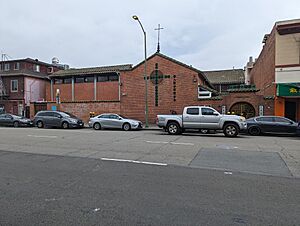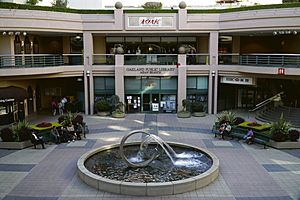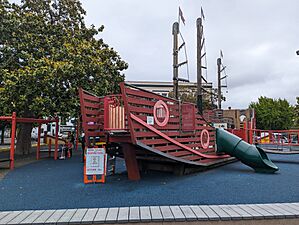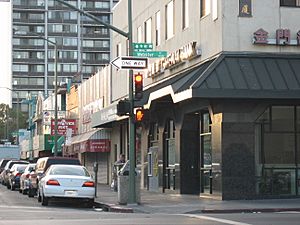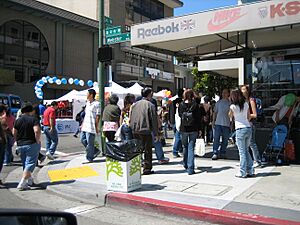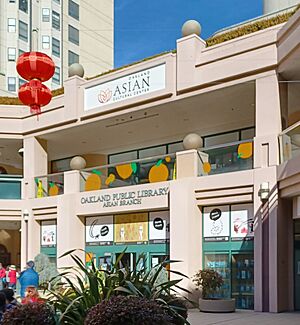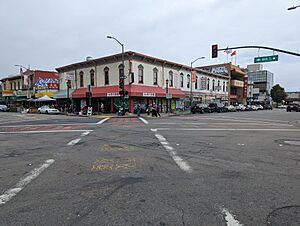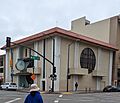Chinatown, Oakland, California facts for kids
Quick facts for kids
Oakland Chinatown
屋崙華埠
|
|
|---|---|

Legendary Palace restaurant at the corner of Franklin and 7th Street in Oakland.
|
|
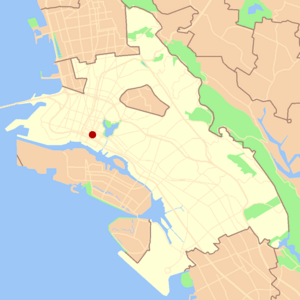
Location of Oakland's Chinatown in the City of Oakland.
|
|
| Country | United States |
| State | California |
| County | Alameda |
| Metro Area | the San Francisco Bay Area |
| City | Oakland |
| Settled | 1850 |
| Annexed | 1852 |
| Elevation | 34 ft (10 m) |
| Time zone | UTC-8 (PST) |
| • Summer (DST) | UTC-7 (PDT) |
| ZIP code |
94607
|
| Area code(s) | 510 |
| BART stations | 12th Street Oakland City Center, Lake Merritt |
| Website | Oakland Chinatown Chamber of Commerce |
Oakland Chinatown is a lively neighborhood in Oakland, California. It's known for its rich Chinese American culture. People often call it "Oakland Chinatown" to tell it apart from the bigger San Francisco's Chinatown nearby. This area is about 39 feet (12 meters) above sea level.
The first Chinese people arrived in Oakland in the 1850s. Later, Japanese came in the 1890s, followed by Koreans and Filipinos. In the 1970s, many Southeast Asians moved here during the Vietnam War. Because of this mix of people, you can hear many different Asian languages and dialects spoken in Chinatown.
Chinatown is in downtown Oakland. Its main area is around 8th Street and Webster Street. It stretches from 12th Street in the north to Interstate 880 (around 6th Street) in the south. It goes from Broadway in the west to the southern part of Lake Merritt in the east.
Contents
Exploring Oakland's Chinatown: A Cultural Hub
Oakland's Chinatown is in the Downtown area. It is bordered by Broadway to the west and Interstate 880 to the south. Fallon Street and Laney College are to the east, and 12th Street is to the north. The main business area is along Webster and 8th Streets.
Unlike many other Chinatowns, Oakland does not have a large, formal entry gate. However, you'll see bilingual street signs in both English and Chinese. These signs help make the neighborhood special.
The neighborhood has two main parts:
- The western half, between Broadway and Harrison Street, is busy with markets, restaurants, banks, and shops.
- The eastern half, east of Harrison Street, has more homes. It has quieter sidewalks and different kinds of stores.
Even though most businesses are south of 10th Street, you can find many shops and restaurants owned by Chinese and Korean people further north. For example, 14th Street between Webster and Harrison has many Korean restaurants.
Important Places to See in Chinatown
Chinese Community United Methodist Church
The Chinese Community United Methodist Church (CCUMC) started in 1887. It was part of a group of Methodist Chinese Missions. In its early days, the church offered worship services and Sunday School. It also had English classes for immigrants and Chinese classes for American-born Chinese children.
The church moved a few times before settling at its current spot on 321 8th Street in 1905. A fire damaged the building in 1913, but a new one was built. As the community grew, a larger church was built in 1952. An extra social hall and classrooms were added in 1970.
Today, the church holds Sunday services in Chinese (Cantonese and Mandarin) and English.
Pacific Renaissance Plaza: A Modern Center
The Pacific Renaissance Plaza was built in 1993. It's a large complex with shops, offices, and homes. Many people see it as the heart of Oakland Chinatown. It has a central fountain where people can sit and relax.
The first two floors have restaurants, jewelry stores, banks, and health services. It's also home to the Asian Branch Library and the Oakland Asian Cultural Center. Above these floors are residential condos and rentals. There's also a three-level parking lot underneath.
Parks and Green Spaces in Chinatown
- Parks in Oakland Chinatown
-
Chinese Garden Park has a small pagoda
-
Junk-themed play structure at Lincoln Square Park
Chinatown has three city parks, each taking up one block:
- Chinese Garden Park is located between Harrison, Alice, 6th, and 7th Streets. It used to be called Harrison Railroad Park.
- Lincoln Square Park is between Harrison, Alice, 10th, and 11th Streets. You can see a colorful mural on the recreation center here.
- Wilma Chan Park is between Jackson, Madison, 8th, and 9th Streets. It was renamed in 2022 to honor Wilma Chan, a local supervisor.
A Look Back: Chinatown's History
How Did Oakland Chinatown Begin?
Oakland Chinatown started in the 1850s when Chinese immigrants first arrived. This makes it one of the oldest Chinatowns in North America. By 1860, about 6% of Oakland's population was Chinese. More Chinese workers came in the 1860s to help build the Central Pacific Railroad. This was the western part of the First transcontinental railroad.
The first Chinese settlers lived in fishing camps near the Oakland estuary. They were also found at 4th and Clay streets. An earlier Chinese settlement burned down in 1867 and moved to a new spot.
Chinatown's Current Location and Growth
In the 1870s, the Chinese community moved to its current location around 8th Street and Webster Street. This move happened partly due to unfair laws and fears about Chinese immigrants.
Early Chinese residents in Oakland fished for shrimp in the San Francisco Bay. They also helped build important dams like the Temescal Dam in 1868 and the Lake Chabot Dam in 1874–75. They worked in many jobs, including canneries and farms.
In the 1880s, laws made it hard for Chinese immigrants to own land or find jobs. Many worked as laundry workers, cooks, or gardeners. The Chinese Exclusion Act of 1882 greatly limited Chinese immigration. By 1900, fewer than 1,000 Chinese people lived in Oakland.
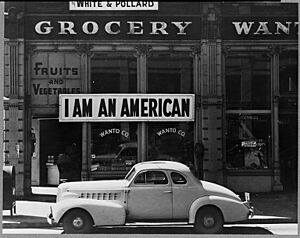
After the Chinese Exclusion Act, people from other Asian countries began to arrive. Japanese immigrants settled in Oakland in the 1890s. Many lived near Harrison and Oak streets. They owned several stores in Chinatown. After the attack on Pearl Harbor in 1941, all Japanese Americans were sent to special camps. The Masuda family, who owned the Wanto Company grocery store, put up a sign saying "I Am An American." Many Japanese Americans did not return to Oakland after the war. The Buddhist Church of Oakland is one of the few remaining Japanese institutions.
Filipinos also moved to the area in the early 1900s. Oakland Chinatown became a key place for Filipino businesses and community life from 1940 to 1960.
How the 1906 Earthquake Changed Chinatown
The 1906 San Francisco earthquake and fire destroyed most of San Francisco's Chinatown. More than 4,000 Chinese survivors came to Oakland for safety. Many stayed in Oakland, increasing Chinatown's population to about 2,500.
In the 1920s, Oakland Chinatown grew even more. By 1940, the population reached about 3,000. During World War II, China was an ally of the United States. This led to the repeal of the Chinese Exclusion Act in 1943. However, immigration was still limited.
Chinatown's Growth After World War II
By 1950, Chinatown's population grew to 5,500. However, some homes were lost due to new construction. This included the building of Interstate 880 and Laney College. Later, the Bay Area Rapid Transit headquarters and Lake Merritt station were also built.
For many years, Oakland Chinatown's economy didn't grow much. Many residents moved to the suburbs in the late 1960s.
Chinatown Today: A Diverse Asian Center
Chinatown saw a lot of new growth in the 1980s and 1990s. Many Chinese American business owners moved from San Francisco to Oakland. More immigrants also arrived from mainland China, Hong Kong, Vietnam, Cambodia, and Thailand. During this time, many Chinese Vietnamese and Chinese Cambodians opened new businesses.
Investors from Hong Kong also built the Pacific Renaissance Plaza in the early 1990s. Oakland's Chinatown still has its traditional feel. It even has a historic fortune cookie factory.
People and Culture in Oakland Chinatown
Oakland Chinatown is home to a mix of people. You'll find Chinese, Hispanic and Latino Americans, African Americans, Vietnamese, Korean, Filipino, Japanese, Cambodian, Laotian, Mien, Thai, and Polynesian people.
Because of this diversity, many languages and dialects are spoken. These include Cantonese, Cebuano, English, Spanish, Chiu-Chow, Ilocano, Japanese, Khmer, Khmu, Korean, Lao, Malay, Mien, Tagalog, Taiwanese, Thai, Toishan, and Vietnamese.
The Oakland Asian Cultural Center offers many cultural programs. These include performances, workshops, festivals, and exhibitions.
Annual Cultural Events and Fairs
Chinatown hosts several exciting events each year:
- Chinese New Year: Also known as Lunar New Year or Vietnamese Tết.
- Dragon boat races: These exciting races happen annually at Jack London Square or Treasure Island, California.
- Oakland Chinatown StreetFest: This festival has been held every year on the fourth weekend of August since 1988.
- Mid-Autumn Festival: Also known as Moon Festival or Vietnamese Tết Trung Thu.
Performing Arts in Chinatown
Chinese opera was one of the first traditional Chinese art forms in Oakland. In 1907, a Chinese Theater opened at 9th and Franklin streets. It could seat 500 people and had 30 full-time actors from China. Today, three types of Chinese opera clubs are active in Oakland: Cantonese opera, Beijing opera, and Kunqu.
Libraries: A Hub for Learning
The Asian Branch Library is part of the Oakland Public Library system. It's located in Chinatown's "Pacific Renaissance Plaza." This library is special because it has books in eight Asian languages. These include Chinese, Japanese, Korean, Vietnamese, Thai, Cambodian, Tagalog, and Laotian. It also has a collection about Asian American studies.
The Asian Community Library started in 1975. It moved to its current location in the Pacific Renaissance Plaza in 1995.
Famous People from Oakland Chinatown
Many notable individuals have connections to Oakland Chinatown:
- Amy Tan, a famous author.
- Ben Fong-Torres, a journalist and radio personality.
- Bruce Lee, a legendary martial artist and actor.
- Dong Kingman (1911–2000), a watercolor artist.
- Dr. Charles Goodall Lee (1881–1973), the first licensed Chinese dentist.
- Frank Chin, a writer.
- Fred Korematsu, who challenged the forced movement of Japanese Americans during World War II.
- Lew Hing (1858–1934), a successful businessman.
- March Fong Eu, a politician.
- Maxine Hong Kingston, author of The Woman Warrior.
- Joe Shoong, founder of the National Dollar Stores and a generous giver.
- Rodney Yee, a yoga instructor.
- William Wong, a journalist and author.
Getting Around and Learning in Chinatown
Transportation in and Around Chinatown
Oakland Chinatown is located near major roads like the I-880 freeway. It's also close to the tubes linking Alameda and Oakland. This means a lot of car traffic passes through the area. Over 100,000 cars use I-880 daily. This traffic can cause air pollution and make walking difficult.
Chinatown has many connections to I-880 and I-980. The city has made changes to streets like Jackson Street to help traffic flow better. However, there are still many car accidents involving pedestrians and bicycles. In fact, Chinatown has the highest number of these types of accidents in Oakland.
To make streets safer, a special pedestrian scramble system was put in place in 2002 at 8th and Webster. This system stops all car traffic to let pedestrians cross in any direction. It was later expanded to other intersections. There are also plans to improve freeway connections to reduce cars on Chinatown's local streets.
Many Chinatown residents use public transportation. About 38% of homes here don't have a car. Visitors also use public transit. Oakland Chinatown is served by several AC Transit bus lines. It also has two nearby BART stations: 12th Street Oakland City Center station and Lake Merritt station.
Education Opportunities in Chinatown
Public Schools Serving Chinatown
Students living in Chinatown attend schools in the Oakland Unified School District. These schools include:
- Lincoln Elementary School (Kindergarten to 5th grade)
- Westlake Middle School
- Oakland Technical High School
There are also charter schools in or near Chinatown. The American Indian Public Charter School II serves students in the Chinatown and Lake Merritt areas. The Lighthouse Community Charter School also started in Chinatown. Yu Ming Charter School, which teaches in Mandarin, used to be located here.
Colleges and Universities Near Chinatown
- Laney College is a community college at the south end of Chinatown. It offers classes in Asian and Asian American Studies, Chinese, Japanese, and Chinese Opera.
- Cal State East Bay has a center nearby. It offers courses like "Teaching Chinese as a Heritage or Other Language."
Other Educational Services
- The Mun Fu Yuen "Chinese school" offers after-school and weekend classes. These classes teach Cantonese and Mandarin to promote Chinese language and culture. The school is at the Shoong Family Chinese Cultural Center on 9th Street. It is the oldest Chinese school in Oakland.
Healthcare Services for the Community
Asian Health Services provides healthcare to the community. Since 1974, they have offered health services to the large Asian population. These services include mental health, dental care, and community support. Their goal is to help those who need medical care, especially immigrant and refugee Asian communities.
Asian Health Services has several buildings in Chinatown, mainly around 8th and Webster Streets. These include the Chenming & Margaret Hu Medical Center and the Rolland & Kathryn Lowe Medical Center.
Images for kids



